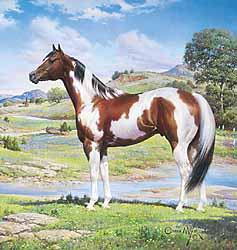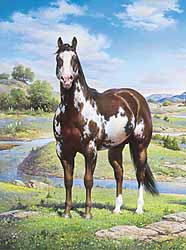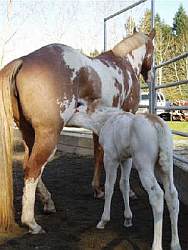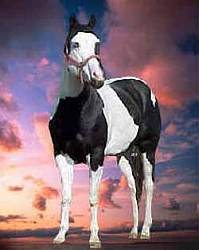Tobiano, Overo, Sabino, Tovero
By Debora JohnsonCoat Patterns: Tobiano, Overo, Sabino, Tovero
Have you ever tried to figure out what all the different coat patterns are called on spotted horses? It may be a Paint, a Pinto, a Spotted Mountain Horse, a Tennessee Walker, a Clydesdale, a Shire, an Arabian, etc. Just how can one identify whether the coat pattern is tobiano, overo, sabino, or tovero? What does this mean? In researching I came across the Spotted Mountain Horse Association Brochure and what follows is almost directly quoted from that brochure. This is the easiest understood write up that I have ever seen. Perhaps this will be informative and helpful to all.
| Tobiano (pronounced: tow be yah' no)
"The dark color usually covers one or both flanks. Generally, all four legs are white, at least below the hocks and knees. Pattern of white markings... commonly take the form of large splashes. Generally, the spots are regular and distinct as ovals or round patterns that extend down over the neck and chest and will travel across the spine extending downward between the ears and tail in a clearly marked pattern. The head is usually dark except for a facial marking pattern -- blaze, strip, star or snip. A tobiano may be either predominantly dark or white. The tail is often two colors. The eyes are usually dark. |
 |
 |
Overo (pronounced: oh vair' oh)
The white originates on the underside of the horse (belly) and will rarely cross the back of the horse between its withers and its tail. Generally, at least one and often all four legs are dark. Generally, the white is irregular, and is rather scattered or splashy. Head markings are predominantly white, often bald, apron, or bonnet-faced. An overo may be either predominantly dark or white. The tail is usually one color. The eyes are commonly blue. |
| Sabino (pronounced: sa bean o) With color and markings similar to the roan, the sabino is generally different. Usually markings will be on the belly and appear to extend outward from the belly as patches that are flecked and roaned, with ragged edges. The legs often have white extending upward in peaks or points along the front or back of the leg bones; disconnected white leg markings are common. The face commonly has a lot of white. The eyes on sabinos are often blue and may have eyes that are partially blue and brown. Sabinos can be all or nearly pure white (appearing extensively roaned), though they will usually retain a small patch of pigmented skin. |  |
 |
Tovero (pronounced: tow vair' oh)
This horse will show characteristics of both overo and tobiano color patterns. Dark pigmentation around ears... may expand to cover the forehead and/or eyes. One or both eyes blue. Dark pigmentation around the mouth... may extend up the sides of the face and form spots. Chest spot(s) in varying sizes. These may also extend up the neck. Flank spot(s) ranging in size. These are often accompanied by smaller spots that extend forward across the barrel, and up over the loin. Spots, varying in size, at the base of the tail." |
Although this is a very complicated business of genetics, it is my hope that these descriptions and pictures may help in the identification of what kind of spotted horse you have or may encounter in your horse life. This is intended to point you in the right direction for more detailed research. I want to thank the Spotted Mountain Horse Association for such a clear explanation of the coat patterns.
What does Piebald or Skewbald Mean?There are a number of words used to describe the typical color and spotting patterns of pinto horses. Essentially, a pinto horse is genetically created when an allele for a spotting pattern is present in addition to the genes that create the underlying base coat color. The precise mechanism that creates spotting is not fully understood, but appears to be a form of leucism. Common terms for describing different types of pinto horses include:
Color
- Piebald: (term more commonly used in nations using British English). A black and white spotting pattern.
- Skewbald: (term more commonly used in nations using British English). A spotting pattern of white and any color other than black, often a chestnut and white horse, (sometimes called "brown and white") but now also used to refer to a bay and white horse. Skewbald horses are less commonly Palomino or Buckskin and white, Roan and white, or any number of other shades.
- Colored: The nations using British English term for Pinto coloration, including both piebald and skewbald.
- Tricolored: A term for horse with three colors (usually bay and white), in nations using British English, a color usually incorporated into the term skewbald.
For More Information:
Molecular Tests for Coat Colors in Horses